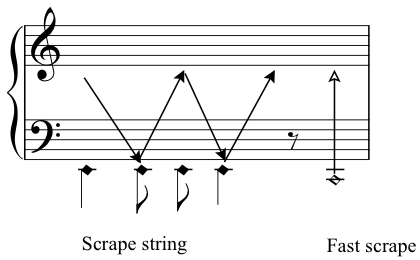Scraping Strings
Production
All the strings of the harp can be scraped vertically, upwards and downwards with the finger or the fingernail. The scrape can be done in one fast movement or slowly over a long period of time.
Sound
The sound differs greatly between the wire and the gut strings. The direction of a scrape does not influence the sound greatly. The difference between an upwards and a downwards scrape is rather a gestural one.
There are three parameters that affect the resulting sound of a scraped string:
1. The speed of the scrape
A fast scrape makes a fast "jet" sound while a slow one makes a sort of "white noise" sound scape.
2. Using fingertip or fingernail
The fingernail is louder and can be used to "play" each winding of the wire strings.
3. Wire string or gut string
Wire strings are wound and therefore make more sound when a finger or a fingernail slides over it. The gut strings are completely smooth and therefore the resulting sound is quite soft.
Notation
A slow scrape is notated by indicating the rhythm of the scrape with diamond-shaped noteheads. The direction of the scrape is indicated with an arrow. A fast scrape or a "jet" slide is notated with a vertical arrow from an open diamond-shaped notehead. The diamond indicates the string on which the scrape should be executed.

Scrape notation.